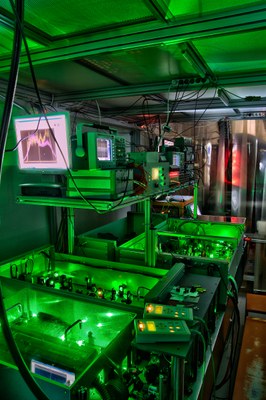Access Facilities - HIJ, Jena, Germany
 |
Contact: Gerhard Paulus Email |
The infrastructure operates several laser systems serving a diverse field of applications ranging from attosecond laser physics to laser particle acceleration. Examples of the extremes are an all-diode pumped 250 TW laser providing 25 J of pulse energy with 100 fs pulse width, a 17 fs 200 TW Ti:sapphire-laser and a kilohertz phase-stabilized few-cycle laser. The institute has equally strong programs in laser development and applications for high intensity laser-matter interactions. For instance, HIJ is engaged in the development of diode pumped near- and mid-infrared high energy ultra-short pulse laser systems as well as high average power lasers with carrier envelope phase control. Application development ranges from particle acceleration (electrons, ions), plasma diagnostics with high temporal resolution (shadography, holography, spectroscopy, reflectometry) to the generation of secondary sources (high harmonics, XUV, X-rays, THz) and their application for imaging technologies like XUV coherence tomography or ptychography, single shot THz imaging and single shot THz-TDS etc.
Excellence:
HIJ has a long-lasting experience in diode-pumped high-power laser development, relativistic optics, few-cycle plasma probing, CE-phase measurement, nanoscale XUV imaging and high intensity laser matter interaction simulation. With more than seven independent high-power laser laboratories a foundation covering many different applications is readily available. Additionally, there are a lot of sophisticated measurement techniques for carrier envelope stabilized laser applications or plasma diagnostics ranging from spectroscopy to dosimetry and imaging at the institute.
Publications:
-B. Schwab et al., Visualization of the Relativistic Laser Intensity Profile in Laser Wakefield Acceleration, Physical Review Accelerators and Beams 23, 032801 (2020)
-Georg A. Becker et al., Characterization of laser-driven proton acceleration from water microdroplets, Scientific Reports 9, 17169 (2019)
-Polz et al., Efficient Laser-Driven Proton Acceleration from a Cryogenic Solid Hydrogen Target, Scientific Reports 9, 16534 (2019)
-N. Rosmej et al., Generation of keV hot near-solid density plasma states at high contrast laser-matter-interaction, Physics of Plasmas 25, 083103 (2018)
-Woldegeorgis et al., THz induced nonlinear effects in materials at intensities above 26 GW/cm², J Infrared Milli Terahz Waves 39, 667 (2018)
-C. Downer et al., Diagnostics for plasma-based electron accelerators, Reviews of Modern Physics 90, 035002 (2018)
-Wustelt et al., Heteronuclear limit of strong-field ionization: Fragmentation of HeH+ by intense ultrashort laser pulses, Physical Review Letters 121, 073203 (2018)
-Kuschel et al., Controlling the self-injection threshold in laser wakefield accelerators, Physical Review Letters 121, 154801 (2018)
-Fuchs et al., Optical coherence tomography with nanoscale axial resolution using a laser-driven high-harmonic source, Optica 4, 903 (2017)
-Kasim et al., Quantitative shadography and proton radiography for large intensity modulations, Physical Review E 95, 023306 (2017)
-Hoff et al., Tracing the phase of focused broadband laser pulses, Nature Physics 13, 947 (2017)
-Gopal et al., Observation of Gigawatt class THz pulses rom a compact laser-driven particle accelerator, Phys. Rev. Lett. 111, 074802 (2013)
|
|


